January 11, 2016
I think my spaceship knows which way to go…
https://www.youtube.com/watch?v=cYMCLz5PQVw
I am not a David Bowie fan. I’ve never bought any of his albums, I only know his most popular songs, and the only David Bowie song I knew for the first decade of my life was “Dancing in the Street” with Mick Jagger; my parents were more Elton John people. The first time I heard “Under Pressure,” I thought it was Vanilla Ice, and I was nearly 20. So I’ve got no cred whatsoever (if you ever thought I did), but I’d be hard-pressed to think of a musician I’m not a fan of whose work has affected me more. This morning we heard that he had died, and I put on “Modern Love” so we could have a dance party in the living room. I played “Let’s Dance” for my dance-loving girls tonight. I’ve been humming “Space Oddity” all day, hearing those amazing harmonies. There was a time in my when everything had fallen apart, and I spent that period listening to that song over and over again, those lines resonating: “The stars look very different today.” And learning to have faith in my own direction: “And my spaceship seems to know which way to go.” Understanding so much what it was to be lonely and lost—no one can be wholly alone whilst listening to that song. And more recently, his song “Kooks” has meant a lot to me, since Elizabeth Mitchell covered it on her album, Blue Clouds (which I love so much—it also features the most gorgeous cover of Van Morrison’s “Everyone.”) We listened to this album all the time when I was pregnant with Iris, and it might have become part of her sonic DNA. “Kooks” is a song about waiting for a baby, and hoping that baby will take its chances on you: “Will you stay in a lovers’ story, if you stay, you won’t be sorry, cuz we believe in you…” And it includes the line that really is my parenting philosophy, particularly in regards to school: “And if the homework brings you down/ Then we’ll throw it on the fire./And take the car downtown.” (Listen to Elizabeth Mitchell’s cover here.)
January 10, 2016
Birdie, by Tracey Lindberg

Last week writers Lee Maracle, Drew Hayden Taylor and Tracey Lindberg spoke on CBC’s The Current about the idea of First Nations book club month (responding to Minister of Indigenous and Northern Affairs Carolyn Bennett’s recent proposal) and what the experience is like being an Indigenous writer in Canada. The program was excellent, and the show was stolen by Maracle, who was indomitable, admirably cantankerous, and an excellent articulator of her situation and that of other First Nations women writers.
Maracle explained, “The balance in reading is not there for Indigenous women. 70% of book buyers are women, but 80% of books sold are men’s—it doesn’t matter what colour you are., So I think that’s a problem in Canada. If you just say Indigenous books, I think Tom King, Drew Taylor, Richard van Camp will get on the list [of suggested titles for a book club], and myself and Tracey will be at the bottom or at the middle.” The numbers back up her experience; in 13 years, for example, Canada Reads has never featured a book by a First Nations women writer—though I suspect this is a wrong that will begin to be righted upon the announcement of this year’s shortlist, which may very well include Tracey Lindberg’s Birdie. In fact, I hope it does.
Birdie is an example of what riches Canadian readers are missing when they’re overlooking First Nations women writers—a novel about women’s lives and experiences, the connections between them, and what happens when those connections are broken. (Think about more than 1000 missing or murdered women across this country—what must those absences be doing to families whose ties are already strained by centuries of colonial atrocities?) Though Birdie is most importantly about a particular woman, Bernice Meetoos, nicknamed Birdie, who has turned up in Gibsons, BC, after years of drifting, a pilgrimage to the place where The Beachcombers was filmed. In her bag, she carries decades-old clippings of Pat John, an actor from the show—”a healthy, working Indian man.” She’s preoccupied by thoughts of John, as well as taking guidance from The Frugal Gourmet, whose PBS cooking show is broadcast on the CBC. Things have not been quite right with Birdie, even more so than usual (and she spent four years living on the streets of Edmonton after all). She’s secured a job at a bakery and even has a place to live, a local woman to watch out for her—but then something breaks. She goes to bed, doesn’t eat, scarcely breathes, won’t be roused. And as ever when help and comfort are needed, it is the women who come.
First, Bernice’s cousin, Skinny Freda, the two of them raised like sisters, although the circumstances of Freda’s parentage are scarcely delineated. And then she sends for their Aunt Val, who’s had her own ups and downs, but is a motheraunt to both women as Birdie and Freda are sistercousins to each other (and such compound words abound throughout Birdie, suggesting that English proper is not up to the task of telling this story, just as the novel as we know it is inadequate to contain it, and therefore chronology is disrupted, notions of realism challenged, the whole book infused with elements of First Nations storytelling and mythology—Lindberg should be celebrated for her pushing the limits of what “the novel” can be). From her bed, in a kind of dream state, Bernice relives the traumas she’s endured, chief among them childhood sexual abuse by her uncles, which culminated in a terrible act of violence (justice?) that leaves her estranged from her family, alone. Until the women come.
Also present, if not physically, is Bernice’s mother Maggie, invoked in the novel’s prologue and epilogue, whose own problems make her not wholly responsible to what happened to her daughter. Bernice’s landlady too, while not Native, becomes part of this collective of women watching over Birdie, suggesting the possibility of womanhood as a connection that goes beyond culture; what happened to Birdie is particular to her situation, but there is a universality to women’s experience. There are so many things that every woman understands—and we see from being close to each character in this collective that each woman has her own tragedies that she carries within her,
Surprisingly, Birdie is not a heavy book, even with all the violence and tragedy. It’s as funny as it is sad, and more than that, it’s vibrant—powered by the voice of a woman who seemingly lies unconscious, which is kind of ironic, but there’s a lot going on inside Birdie’s mind, even as she’s got one half-opened eye on The Frugal Gourmet. As a character she’s rich and realized, and Lindberg never makes her a victim of her circumstances, her agency retained even in her lowest moments. Her very act of retreating into her mind, while passive from the outside, is a powerful gesture, and necessary for healing, for the possibility of a future.
January 8, 2016
All Year Round, by Emilie Leduc
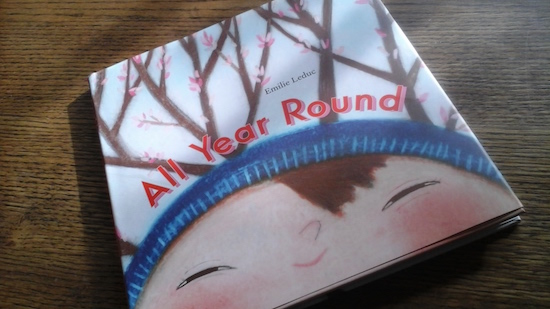
The new year is a perfect occasion to pick up All Year Round, written and illustrated by Emilie Leduc and translated from French by Shelley Tanaka. While it’s a truth universally known that there is no months-of-the-year book as perfect as Maurice Sendak’s Chicken Soup With Rice, it’s nice to also have another book that actually makes sense. Even if it fails to contain the line, “Whoopy once! Whoopy twice!”—my one criticism of this book. And most books, actually.
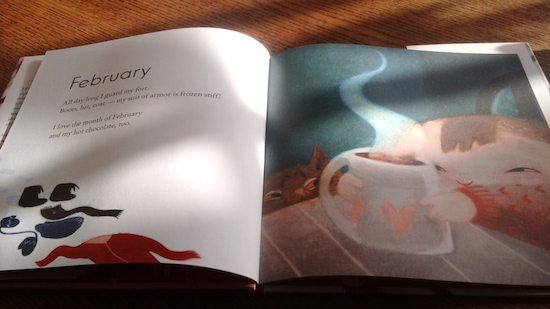
Each month includes a prose poem and beautiful celebratory illustration from a child’s point of view. Plus, a glimpse of a cat called Clementine, much to any young reader’s delight.
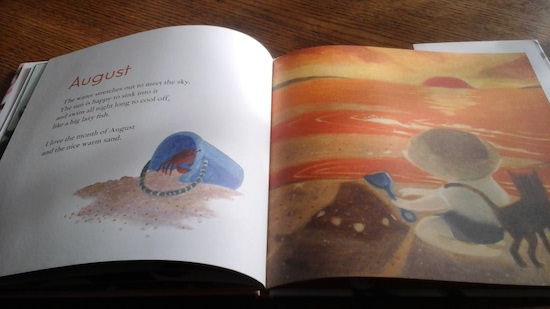
Every month and every season contains something wondrous, and that each month hinges on a non-secular occasion offers this book a perfect universality.
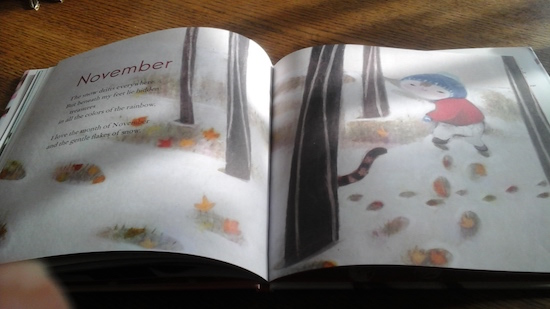
This book is a story about the rhythms of our world and of our lives—just as good as riding a crocodile down the chicken soupy Nile!
January 6, 2016
Today’s Teacup

I read this article by Globe and Mail reporter Janet McFarland years ago about children’s birthday parties gone wild and learning to take joy in small things. Her line about “an ‘ooh, doesn’t that look lovely’ contentment with a cup of tea or a few biscuits on a plate” (inspired by Bill Bryson’s thoughts on the English) has stayed with me ever since, and I’ve long made a point of trying note the smallest of ceremonies, the secret pleasures of the every day, even if sometimes it’s a ginger snap. I mean, as opposed to a chocolate digestive.
But I also have a sizeable collection of mugs and teacups, which I’m conflicted about. The teacups and their saucers less so because they’re delicate and lovely, and get pulled down and dusted off for special occasions. But yes, the mugs, because there’s really nothing sadder than a mug, stained, unwanted, abandoned in an office cupboard. The most depressing kind of gift—World’s Best Dad. I mean, I love mugs—some mugs. My mom gave me the most wonderful ceramic mug for my birthday, and it’s nearly replaced my Cath Kidston mug with the crack in it in terms of mugs of my heart. But then there are the mugs that slip on in to the back of the cupboard and all they’re doing is taking up space, and some of them are even wonderful—the Pyrex mug that Stuart found on the street and brought home because these are the mugs that remind me of summer, and the Miffy mugs we got in Japan, and my Diamond jubilee mug, and the mug with the M on it that my friend Jennie bought for me when we published The M Word. But what am I supposed to do with all these things?
I’ve been helped out of this philosophical quandary, however, with the help of Instagram. Because I am WILDLY SPONTANEOUS, I mixed up things mug-wise after receiving a gorgeous new orange mug from my friends Erin and Rebecca this weekend. This mixing only caused me a minimal amount of anxiety, until I realized that I could actually mix up mugs all the time (I know—crazy) and feature my eclectic mug/teacup collection on Instagram (because I’m in the posting-cups-of-tea population of Instragram users, as opposed to the taking-shots-of-myself-doing-yoga-on-a-beach crew). The trouble with mugs, I think, or at least the ones in the back of the cupboard, is that they serve no purpose, but they’ve been purposed now. Because #todaysteacup has been born.
Silly, frivolous, meaningless—but I don’t think so. It’s about the ceremony. About taking stock of the moment, the light, the cup of tea. It’s about using what you have, and having things that matter.
January 5, 2016
Lottie: Empowering Girls from Outer Space

We discovered Lottie Dolls over a year ago, and their premise intrigued me. A proper alternative to Barbie, designed to empower girls and their play. I wrote about them here (and check out the pictures! Iris was still a baby! Harriet was so little). It could have been a one-time thing, but I return to Lotties because now it’s my girls who are crazy about them. They’re the one toy, along with Legos, that gets returned to again and again, and they play with them together, which I love so much. We have five or six of them, and received more for Christmas, along with two new Lottie outfits, including the Superhero Lottie suit shown above, which has proven very popular—this is the one Lottie who never gets her clothes changed. When Harriet and Iris received Christmas money from their grandfather last week, they knew what they wanted to buy with it—more Lotties. And so we’re currently awaiting Rockabilly Lottie and Spring Celebration Ballet Lottie in the mail, expected delivery scheduled for tomorrow. Everybody is very excited.
Though we’ve also got our eye on Stargazer Lottie, who was sold out from Indigo.ca when we made our order last week. (Darn!). Like all the Lottie dolls, she’s designed around what she can do and be rather than how she looks (although admittedly, once they’re indoctrinated into Harriet’s play, the Lottie dolls also take on peculiar new identities…) I was so interested to read this post about how Stargazer Lottie was designed in consultation with an astronomer, and even more thrilled to learn that a Stargazer Lottie doll was currently in space with British astronaut Tim Peake on the International Space Station.
And most remarkable? That none of this would have happened at all without a six-year-old girl from Comox, British Columbia, who helped dream up the Stargazer Lottie doll. I showed the video below to Harriet who had her mind blown, and then went to put on her own dress with a space print and proceeded to have her head in the stars for the rest of the day, totally inspired.
January 4, 2016
Holiday Reading Joy

One day back into our routine, and I find I’m happy to be here. It’s been so long, with the sick-filled holidays and my three-plus weeks of pneumonia, and while I was nervous about this return to the real world, I find it much more pleasant and even more relaxing than where we’ve been lately. Although, granted, this is after just one day. Get back to me, perhaps, at the end of the week. But the one thing I do miss about the holiday was the reading—it was wonderful.
I was reading not-new and not-notable books in the weeks before Christmas, and enjoying the experience entirely. But then I picked up Niagara Falls All Over Again by Elizabeth McCracken, and found myself reading notably in spite of myself. It was so terrific. I’d adored McCracken’s short story collection, Thunderstruck, and I spent last Christmas Day sobbing while reading her exquisite memoir, An Exact Replica of a Figment of My Imagination. I read her The Giant’s House last summer, and liked it well enough, but it lacked the immediacy of her other books. And I had been reluctant to finally pick up Niagara Falls… because it was about men, a comedy team who find fame on the vaudeville circuit and in the golden days of Hollywood—nothing about that grabbed me. But the book did. Oh, its pacing, and energy, and to be so sad and so funny, and so completely realized. Truly, one of the best not-new books I read in 2015, and I’m so pleased that I finally did.
After that, I read Cassandra at the Wedding, which I bought at Ben McNally Books right before Christmas. I bought this one on the recommendation of Sarah from Edge of Evening, and was so pleased that I did. As Sarah writes, Dorothy Baker conjures Joan Didion in her setting but is entirely different in tone and approach—more wry than wrought, humour bubbling to the surface even in the darkest moments. It’s a book about twin sisters that seems like a great companion to Libby Crewman’s new novel, Split. About the connection between sisters and what happens when it’s severed, and how one person’s reality can be interpreted by another. Like so many books published by New York Review Books, Baker is doing fascinating things with narrative voice, and I appreciate how hearing from the slightly-deranged Cassandra’s sister Judith turns the whole story on its heel.
Then I read Inside Out, which is an essay by Rebecca Solnit with paintings by Stefan Kurtan. I’d asked for it for Christmas because I love Rebecca Solnit and wish to read everything she’s ever written, and also because it’s an essay on the subject of houses and homes, which I find really interesting. And it was. I loved her thoughts on materials and materialism, and the home as an extension of the female body while the automobile is that of the male (and therefore mobile), which connected to all kinds of things I’ve been thinking about Mad Men as we’re rewatching Season 1. Reading Rebecca Solnit is never not satisfying, and the book is beautiful.
I read Because of the Lockwoods next, by Dorothy Whipple. A Persephone Book, which is never short of extraordinary. I bought it in April when we were in London, because we’d been visiting Lancashire and she’s a Lancashire author and also because she is compared to Barbara Pym, similarly ripe for a revival, says Harriet Evans, but even a better writer. Whipple (whose unfashionable name is perhaps part of the reason she’s so fallen out of favour, writes Evans) is meant to be utterly readable, her novels absorbing. But I was dismayed to discover that they’re also 500 pages long, and you know how I feel about long books. It was one thing to carry such a doorstop across the sea, but then to actually pick it up and read it? Clearly I needed a holiday, a bit of space in which to make the long read happen—but then the book turned out to be everything Evans said. I read the whole thing in 2 days and now want to read everything in print by Dorothy Whipple. The novel was engaging, surprising, rich with complex characters and situations. I really loved it. Was dismayed to read that Virago Books was so thorough anti-Whipple. Thank goodness for Persephone for bring her back in print.
And then finally, I read The Magician’s Book: A Skeptic’s Adventures in Narnia, by Laura Miller, which was a marvellous celebration of reading, of literary criticism, and of the Narnia books and their creator, as well as critiquing the considerable problems with the two latter points. As we’re smack in the middle of reading the Narnia series (all of us for the first time!) in our family, I was glad to learn so much more about them and their context, and there was no shortage of fascinating Narnia and CS Lewis trivia, so that I become as uninteresting as I always do whilst reading excellent non-fiction (avidly sharing details, beginning every sentence with, “Did you know…) We’re reading Prince Caspian now, and I’m loving it all the more for Miller’s book.
December 31, 2015
New year, new books, new teapot, etc.
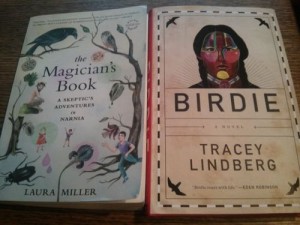 We have had a stupidly crummy holiday, mostly for non-monumental reasons. A year ago I wrote this post about our family’s talent for leisure and enjoying ourselves—we were skating, movie-going, relaxing, lunching, going offline for an actual week, etc.—but we were showing none of those tendencies this time around. Things got off to a good start, but Harriet came down with a stomach bug on Christmas Eve that stayed around for a few days. Iris stopped sleeping over Christmas, and was conspiring to kill me. Stuart was diagnosed with strep throat, and while I was pretty well post-pneumonia, I was so tired and crabby. We weren’t terribly ambitious then—some days our big outing was to the grocery store. Though there were a few highlights—before it all went wrong, we had a fun day downtown(er) and got to visit Ben McNally Books, where I picked up Birdie by Tracey Lindberg, which I’m about to begin as soon as I publish this post. We had nice visits with my parents, who braved our company. Lunch at Fanny Chadwicks yesterday, though Stuart is still unable to eat solids, so he didn’t have the greatest time. Tonight we’re going to our friends for a New Years get-together, though we won’t be staying too long (and I am sure nobody else at the party is too upset about that. We’ve become social pariahs).
We have had a stupidly crummy holiday, mostly for non-monumental reasons. A year ago I wrote this post about our family’s talent for leisure and enjoying ourselves—we were skating, movie-going, relaxing, lunching, going offline for an actual week, etc.—but we were showing none of those tendencies this time around. Things got off to a good start, but Harriet came down with a stomach bug on Christmas Eve that stayed around for a few days. Iris stopped sleeping over Christmas, and was conspiring to kill me. Stuart was diagnosed with strep throat, and while I was pretty well post-pneumonia, I was so tired and crabby. We weren’t terribly ambitious then—some days our big outing was to the grocery store. Though there were a few highlights—before it all went wrong, we had a fun day downtown(er) and got to visit Ben McNally Books, where I picked up Birdie by Tracey Lindberg, which I’m about to begin as soon as I publish this post. We had nice visits with my parents, who braved our company. Lunch at Fanny Chadwicks yesterday, though Stuart is still unable to eat solids, so he didn’t have the greatest time. Tonight we’re going to our friends for a New Years get-together, though we won’t be staying too long (and I am sure nobody else at the party is too upset about that. We’ve become social pariahs).
I did, however, get a lot of reading done, mostly because my evening companion took to going to bed at 8pm, and I took a holiday from work things and read all through nap times (bliss!). My holiday reads were not at all disappointing, mercifully, and I look forward to writing a post about them this week. My final read of the year was a gift from Stuart (who got me so many excellent bookish things), The Magician’s Book, by Laura Miller (and we’re going to be starting Prince Caspian in a few days and I am so excited). My final read of 2015 then, followed by my first read of 2016—Birdie. I really want to keep a focus on reading First Nations women writers.
 Anyway, a disappointing holiday is winding down on the right note. Iris’s weird rash (of course she has a weird rash!) is clearing up, if that’s any indication. Today I did receive the great joy of not only a pair of Hunter wellies in the post, but a brand new teapot. And why did I need a teapot, you might ask, seeing as I came into possession of the greatest teapot on earth just six months ago? Well, on Christmas Day, my teapot got smashed, which led to sulking and petulance on my part, and put a damper on our holiday on top of everything, because I am shallow and materialistic. (But it’s a teapot! Not just any ordinary material.) The bright side of your teapot smashing though is that you get to wait for a new one to come in the post. (I wanted a London Pottery teapot, you see.) There seemed to be no more white polka-dots to be had for love nor money, but I was able to order a plain red one from the shop I’d bought the last one from in Bobcaygeon. And it arrived quickly and intact, alongside my new wellies which replaced a) the wellies I’d got for Christmas that didn’t fit and b) the wellies my mother-in-law bought me for my 26th birthday a decade ago and whose image was for a time my blog header and can still be seen if you scroll all the way down to the bottom of this page, and which finally started leaking after many years of service. So things are certainly on the up-and-up.
Anyway, a disappointing holiday is winding down on the right note. Iris’s weird rash (of course she has a weird rash!) is clearing up, if that’s any indication. Today I did receive the great joy of not only a pair of Hunter wellies in the post, but a brand new teapot. And why did I need a teapot, you might ask, seeing as I came into possession of the greatest teapot on earth just six months ago? Well, on Christmas Day, my teapot got smashed, which led to sulking and petulance on my part, and put a damper on our holiday on top of everything, because I am shallow and materialistic. (But it’s a teapot! Not just any ordinary material.) The bright side of your teapot smashing though is that you get to wait for a new one to come in the post. (I wanted a London Pottery teapot, you see.) There seemed to be no more white polka-dots to be had for love nor money, but I was able to order a plain red one from the shop I’d bought the last one from in Bobcaygeon. And it arrived quickly and intact, alongside my new wellies which replaced a) the wellies I’d got for Christmas that didn’t fit and b) the wellies my mother-in-law bought me for my 26th birthday a decade ago and whose image was for a time my blog header and can still be seen if you scroll all the way down to the bottom of this page, and which finally started leaking after many years of service. So things are certainly on the up-and-up.
I’ve had a good year, even though it’s gone out with pneumonia (but then having pneumonia was terrific, from a reading point of view…). I am pleased that I sold my novel and am excited to turn it into an actually book over the course of this year, though I still can’t quite believe that’s going to happen. I read a lot of good books. I had a splendid trip to England, the land of teapots and wellies. I learned to write profiles, which was a new challenge—I wrote about Julie Morstad in Quill & Quire and have a cover story forthcoming in my alumni magazine. I’m pleased with my review of Marina Endicott’s new novel in The Globe and really, really proud of my essay on Ann-Marie Macdonald’s Adult Onset, which was another challenge and I’m so happy to have met it. I want to keep expanding my writerly horizons. Readerly ones too.
This fall has been exhausting. When I look back, it seems like getting pneumonia was inevitable. It doesn’t help that Iris’s sleep is so patchy, as it’s ever been. My resolution for 2016, if I had one, would probably involve getting more sleep, if that weren’t at the expense of so many things, but I will make an effort. It might also involve baking fewer cakes, but this kind of thing is why I don’t go in for resolutions in the first place.
Happy New Year to you, and thank you for reading!
December 21, 2015
Merry Christmas!

Today we went to the 12 Trees of Christmas display at the Gardiner Museum, which was amazing, and will most likely become a new family tradition. It’s on until the beginning of January, and definitely worth a visit—Harriet and Iris thought the trees were great, and this one was my favourite, for obvious reasons. Tomorrow we’re venturing into ROM holiday madness, and then to the Maurice Sendak Exhibit at the Toronto Reference Library (because when we tried to go yesterday, the library was closed…). Days that follow will feature AGO Brunch, Christmas windows at The Bay (and a trip to nearby Ben McNally books, eh?), skating at City Hall, and lots of do-nothingness too. And reading. Always, reading.
See you in the new year.
December 21, 2015
The Adventures of Miss Petitfour, by Anne Michaels, illustrated by Emma Block
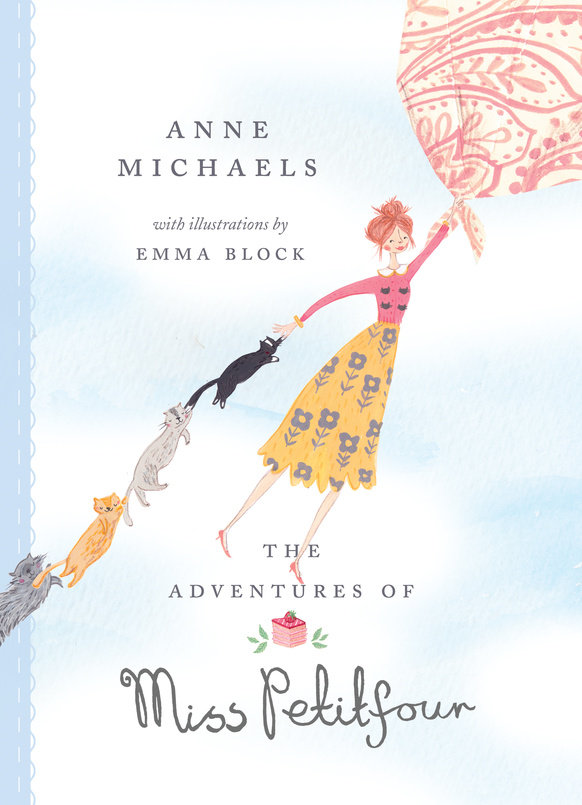
While The Adventures of Miss Petitfour is indeed world-renowned writer Anne Michaels’ first book for children, it might be as accurate to state that it was written exactly for me. Bizarrely so. Right down to the bunting and teapot and caked goods on the endpapers. There is a jumble sale in the second chapter, for heaven’s sake, and every adventures ends with a tea party. There is an entire chapter about cheddar cheese. This was the other book that I bought last week, and we spent every night reading it together, being positively delighted. (Please do read this post by Lisa Martin, inspired by Doris Lessing, on the necessity of the capacity for delight as a precondition for resilience.) If a Barbara Pym novel married Mary Poppins, this book would be their progeny.
“Some adventures are so small, you hardly know they’ve happened… Other adventures are big and last so long, you might forget they are adventures at all—like growing up. And some adventures are just the right size—fitting into a single, magical day. And these are the sorts of adventures Miss Petitfour had.”
Miss Petitfour travels by table cloth, which is a terrific twist on the magic carpet, and much more scientifically plausible. She holds the table cloth just so and lets it fill with wind, and then up she goes (after she has taken “a measure of the meteorological circumstances, that is to say, the weather”), her sixteen cats trailing along for the journey. And their adventures are rich with digressions, narrative and actual, as well as bookishness, confetti, misdirections and festoonery. Charged with whimsy and fun, there is an underlying intelligence to these stories, which are so very much about words:
“People often say that children have no use for long words, but frankly, Mrs. Collarwaller [the bookseller] found this never to be the case. In her vast experience, children loved books that contained words such as propitious, perambulator and gesticulate, especially if they all ended up in the same sentence. The kind of word your tongue could get tangled up and lost in.”
In Miss Petitfour’s local bookshop, there are two sections: one side for adventure books and the other for books in which nothing happens (“the hum and the ho-hum”). In the most perfect way (in addition to the story about cheddar, there’s one about a runaway postage stamp, for example), this books manages to be both.
December 19, 2015
Light the Darkness
 But of course, lighting the lights isn’t all of it. Marsha Lederman wrote a great column in the Globe this weekend about how terrible the holiday season can be for those whose spirits are far from bright. The example she gave of someone having to linger in the grocery store deli listening to “I’ll Be Home For Christmas” after having lost a loved one. Harriet’s school choir sang “Have Yourself a Merry Little Christmas” in their concert this year, and while it’s long been one of my least favourite Christmas songs (I’m more of a “Silver Bells” kind of gal), I kept choking on the line about, “Through the years we all will be together—if the fates allow.” An ordinary wish, I suppose, though the older one gets, the more you realize how extraordinary a fortune is such a thing. It reminds me of Joan Didion writing in Blue Nights about her daughter’s wedding, not long after which her daughter died. She wrote, “Do notice: We still counted happiness and health and love and luck and beautiful children as ‘ordinary blessings.'”
But of course, lighting the lights isn’t all of it. Marsha Lederman wrote a great column in the Globe this weekend about how terrible the holiday season can be for those whose spirits are far from bright. The example she gave of someone having to linger in the grocery store deli listening to “I’ll Be Home For Christmas” after having lost a loved one. Harriet’s school choir sang “Have Yourself a Merry Little Christmas” in their concert this year, and while it’s long been one of my least favourite Christmas songs (I’m more of a “Silver Bells” kind of gal), I kept choking on the line about, “Through the years we all will be together—if the fates allow.” An ordinary wish, I suppose, though the older one gets, the more you realize how extraordinary a fortune is such a thing. It reminds me of Joan Didion writing in Blue Nights about her daughter’s wedding, not long after which her daughter died. She wrote, “Do notice: We still counted happiness and health and love and luck and beautiful children as ‘ordinary blessings.'”
It’s been a weird few weeks. We have friends who are facing merciless illnesses at the moment. I think about the loved ones of those killed in Paris a month ago, and in the shootings that are happening in America all the time. I think of the people I know, many parents of young children, who’ve died in the last year or two. Friends who’ve recently lost their parents. Last week, a colleague of Stuart’s—by all accounts a truly excellent human being—was killed in a random stabbing while out for an evening walk. There is so much inexplicable sadness, so much darkness, as, I suppose, befits this time of year.
But isn’t that why we light the lights? Last Sunday on the last night of Hanukkah, our neighbours invited us over and let Harriet light their candles. I stayed upstairs battling it out with stubborn shortbread while listening to Darlene Love, but the sounds of their singing came up through the vents, and I caught the sparkle and glow of our own Christmas tree down the hall, and it all seemed to me quite sensible why we do what we do at the darkest time of year, not frivolous at all. With the winter solstice just days away, the sun down before five p.m. every day, we light candles, turn on lights, and we sing together, songs about tidings of comfort and joy.
Life is hard and the world is cruel—and yet I’m so glad I get to live in it.
I reread Rebecca Solnit’s “Woolf’s Darkness” again. I find myself returning to that essay, reading it over and over again, getting lost inside its twists and turns. I read it for comfort and insight, for the way it lights the darkness. For the situating of hope as somewhere between the certainties of despair and optimism. “To me, the grounds for hope are simply that we don’t know what will happen next, and that the unlikely and the unimaginable transpire quite regularly.” I think about the line that follows the “through the years…” one in “Have Yourself a Merry Little Christmas”: hang a shining star upon the highest bough. A song I hate a little less now.
For those of us who can, we have to light up the darkness. And then find as many ways as possible to let others in on the glow.





